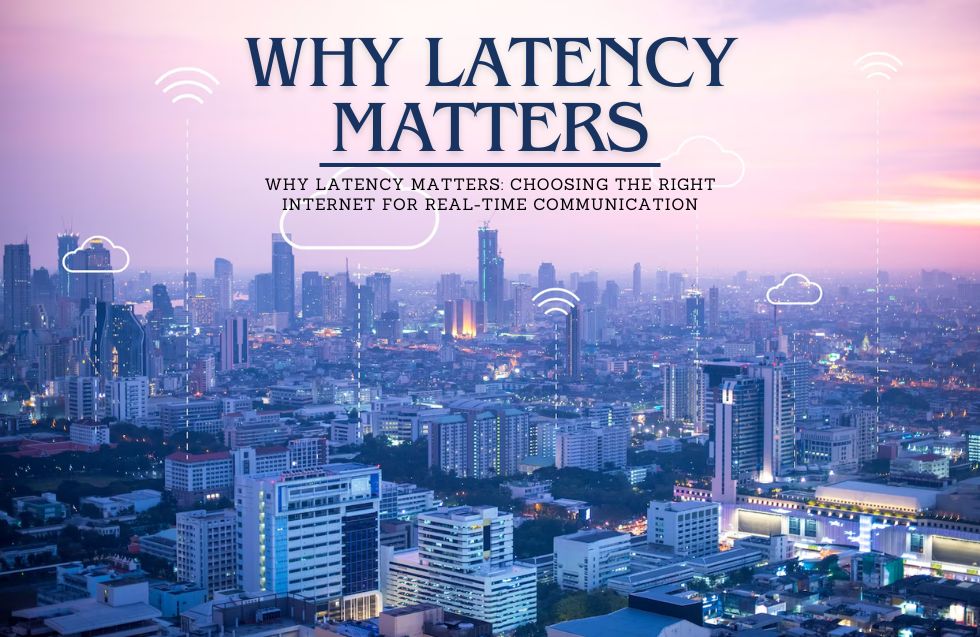In our hyper-connected world, the demand for real-time communication has never been greater. Whether it’s a virtual business meeting, a video call with a loved one, or an online gaming session, the quality of our interactions often hinges on one crucial factor: latency. But what exactly is latency, and why does it matter so much when choosing an internet connection? In this blog, we’ll explore the concept of latency, its impact on real-time communication, and how to select the right internet service to minimize its effects.
What is Latency?
Latency, in simple terms, refers to the time it takes for data to travel from its source to its destination. It’s usually measured in milliseconds (ms) and is sometimes referred to as “ping.” Unlike bandwidth, which measures the amount of data that can be transmitted per second, latency measures the delay in data transmission. Lower latency means that data packets travel faster, resulting in quicker communication between devices. Choosing Frontier Business Internet, which offers high-speed fiber optic connections, can significantly reduce latency and improve the quality of real-time communication.
The Importance of Low Latency in Real-Time Communication
Latency plays a critical role in the quality of real-time communication. Here are some key areas where low latency is essential:
- Video Conferencing and VoIP Calls: High latency can disrupt the flow of conversation, causing delays, echoes, or dropped calls. When latency is low, conversations are seamless, making it easier to communicate without interruptions or misunderstandings.
- Online Gaming: For gamers, especially in competitive settings, latency can make or break the experience. High latency results in lag, where actions performed by a player are delayed, putting them at a disadvantage. Low latency is crucial for ensuring responsive and accurate gameplay.
- Virtual Reality (VR) and Augmented Reality (AR): In immersive technologies like VR and AR, latency can affect user experience significantly. High latency can cause motion sickness or discomfort, while low latency allows for smoother and more realistic interactions.
- Live Streaming and Broadcasting: Low latency is essential for live streaming and broadcasting events such as sports, news, or concerts, where delays can affect viewer engagement and satisfaction.
Factors Affecting Latency
Several factors can influence the latency of an internet connection:
- Distance: The physical distance between the source and destination of data affects latency. Data packets travel at a finite speed, so the farther the data has to travel, the higher the latency.
- Type of Internet Connection: Different types of internet connections, such as fiber optic, cable, DSL, and satellite, have varying latencies. For example, fiber optic connections generally have lower latency compared to satellite connections, which involve data traveling to and from space.
- Network Congestion: High traffic levels on a network can lead to congestion, causing delays in data transmission. During peak hours, when many users are online, latency may increase.
- Routing and Intermediaries: Data packets often pass through multiple routers and servers before reaching their destination. Each “hop” adds a small amount of delay, contributing to overall latency.
- Quality of Service (QoS) Settings: Some internet service providers (ISPs) offer Quality of Service settings that prioritize certain types of traffic, such as VoIP or gaming, to reduce latency.
How to Choose the Right Internet Connection for Low Latency
To ensure the best experience for real-time communication, it’s essential to choose an internet connection that offers low latency. Here are some key considerations:
- Opt for Fiber Optic Connections: Fiber optic internet is generally the best option for low latency. It uses light to transmit data, which results in faster speeds and lower latency compared to other types of connections like cable or DSL. If fiber optic is available in your area, it’s worth considering for the best real-time communication experience.
- Avoid Satellite Connections for Real-Time Needs: Satellite internet tends to have the highest latency due to the long distance that data must travel to and from satellites in orbit. While it can be a viable option for remote areas, it’s not ideal for activities that require low latency, such as video calls or online gaming.
- Check the ISP’s Latency Performance: Some ISPs provide information on their average latency performance. Look for ISPs that have a reputation for low-latency networks. You can also use tools and websites that measure internet performance, such as Ookla’s Speedtest, to check latency before committing to a service.
- Consider Wired Connections Over Wi-Fi: While Wi-Fi is convenient, it can introduce additional latency, especially if the signal is weak or interfered with by other devices. For critical real-time communication, using a wired Ethernet connection can help to reduce latency.
- Monitor and Manage Network Traffic: Using a router that supports Quality of Service (QoS) settings can help to prioritize real-time communication traffic over less important data, reducing latency. Additionally, minimizing the number of devices connected to the network and avoiding heavy data usage during critical times can help to maintain lower latency.
The Future of Low-Latency Internet
As technology advances, the demand for low-latency internet will only continue to grow. Emerging technologies like 5G promise to significantly reduce latency for mobile connections, enabling new possibilities for real-time communication, remote work, and immersive experiences. Additionally, ISPs are investing in infrastructure improvements, such as expanding fiber optic networks and implementing more efficient routing protocols, to meet the increasing need for low-latency connections.
Conclusion
Latency is a crucial factor that affects the quality of real-time communication. Whether you’re making a video call, gaming online, or engaging in a virtual reality experience, low latency is key to ensuring smooth and uninterrupted interactions. By understanding what causes latency and choosing the right internet connection, you can enhance your real-time communication experience and make the most of today’s connected world.
When selecting an internet provider, prioritize low-latency options like fiber optic connections, consider the specific needs of your real-time activities, and take steps to optimize your home network. By doing so, you’ll be better equipped to handle the demands of modern communication and enjoy a more seamless digital experience.












